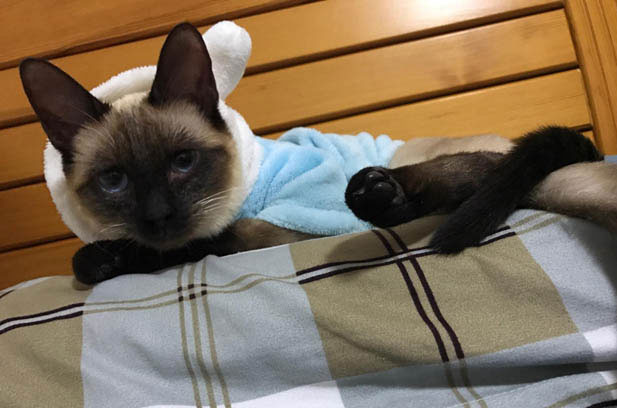Siamese cats, originating from the warm climate of Thailand, have distinct physiological characteristics that make them more susceptible to the cold compared to ordinary feline companions. Understanding and addressing their vulnerability to low temperatures, as well as ensuring their safety during outdoor activities, are essential aspects of responsible Siamese cat ownership.
As a breed hailing from Thailand, Siamese cats’ bodies are naturally adapted to warmer environments. When the temperature drops, especially during the autumn and winter months, they are at a higher risk of discomfort and health issues related to the cold. Take my Siamese cat, Xingxing, for example. As soon as autumn arrives, I notice it seeking warmth by snuggling into the cozy confines of my bed. To keep Xingxing comfortable and healthy throughout the colder seasons, I take proactive measures. During winter, I maintain a warm indoor environment by keeping the air conditioner running. When I’m at home, I use a space heater instead, which not only provides targeted warmth but also helps save energy while ensuring safety.

The importance of warmth becomes even more crucial after a Siamese cat undergoes sterilization. Post – surgery, their bodies are in a weakened state, making them more sensitive to the cold. For cat owners planning to have their Siamese cats sterilized as the weather cools down, it’s essential to take extra precautions. When transporting the cat to and from the veterinary clinic, placing a small blanket inside the cat carrier or travel crate can offer much – needed insulation and protection against the chilly wind. This simple act can significantly contribute to the cat’s comfort and recovery process.
Siamese cats are known for their adventurous spirits and can be taken out for walks, but ensuring their safety during these outings is of utmost importance. Unlike dogs, Siamese cats are not inherently bold. They can easily become frightened when approached by strangers or other animals, such as dogs. To guarantee a safe and enjoyable outdoor experience for both the cat and the owner, several key precautions should be followed.
Firstly, it’s advisable to limit the distance of the walks.Currently, I only take Xingxing to a fixed area downstairs from our home. Even in this familiar environment, Xingxing often tires quickly and prefers to be carried after a short stroll. Sticking to nearby locations reduces the risk of the cat getting lost or overwhelmed in unfamiliar surroundings.
Secondly, protecting the cat from potential stressors is crucial. Avoid allowing passersby to crowd around and touch the cat, as this can cause anxiety. When encountering dogs, promptly pick up the cat to prevent any possible conflicts and injuries. In crowded areas, it’s also best to carry the cat to avoid the risk of it getting startled and running away.
Monitoring the cat’s state is another vital aspect of outdoor activities. Signs such as rapid breathing (visible by the quick rise and fall of the abdomen), flared nostrils, dilated pupils, flattened ears (also known as “airplane ears”), a low – slung posture, or a puffed – up coat indicate that the cat is feeling stressed. Once these signs are observed, it’s important not to push the cat any further and instead bring it back home immediately to ensure its well – being.
Lastly, be cautious about the environment where the cat plays. Avoid taking Siamese cats to areas with dense vegetation, such as grassy patches or wooded areas, which are breeding grounds for mosquitoes and other parasites. Cats that frequently go outdoors require more frequent deworming treatments. It’s recommended to administer external deworming medications once a month and internal deworming medications every two months to safeguard their health. By following these guidelines, Siamese cat owners can provide their beloved pets with a warm, safe, and fulfilling life.
Leave a Reply